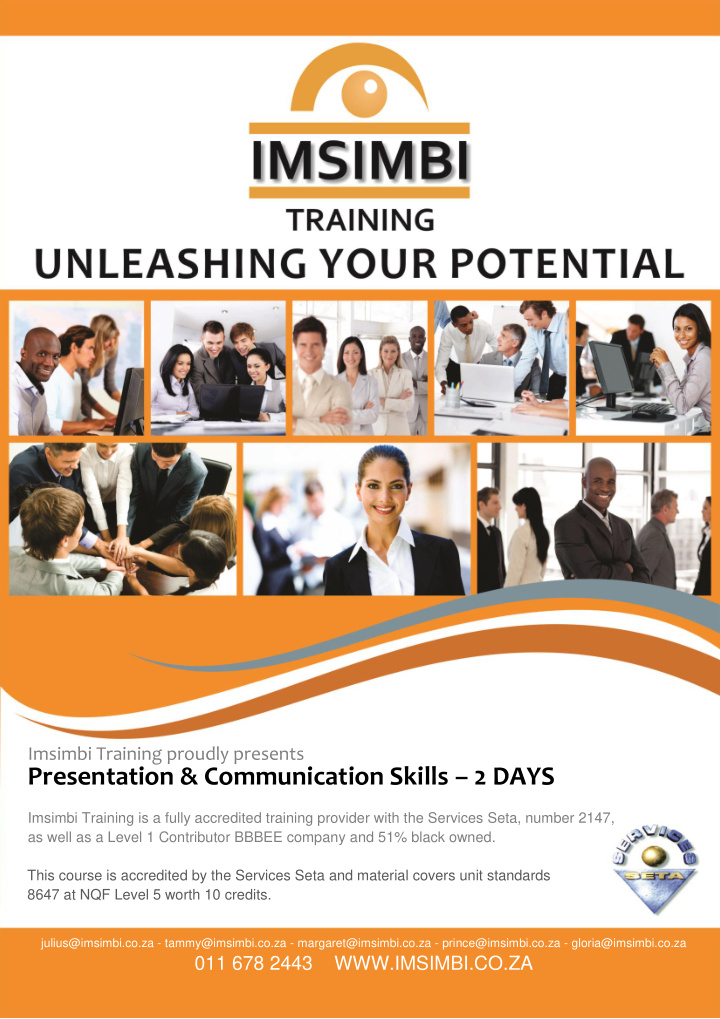



Imsimbi Training proudly presents Presentation & Communication Skills – 2 DAYS Imsimbi Training is a fully accredited training provider with the Services Seta, number 2147, as well as a Level 1 Contributor BBBEE company and 51% black owned. This course is accredited by the Services Seta and material covers unit standards 8647 at NQF Level 5 worth 10 credits. julius@imsimbi.co.za - tammy@imsimbi.co.za - margaret@imsimbi.co.za - prince@imsimbi.co.za - gloria@imsimbi.co.za 011 678 2443 WWW.IMSIMBI.CO.ZA
COURSE OBJECTIVES The broad learning objective of this course is to develop the awareness, knowledge, skills and attitudes of participants needed to deliver effective professional presentations. The course is designed so that participants understand the theory of good communication prior to preparing and delivering a presentation within a simulated context. The course is divided between what good communication is, how to prepare an effective presentation, and delivering your presentation so that you have a persuasive impact on your audience. Each participant will be given an opportunity to do a video recorded presentation in front of the class and be given individual feedback on how to continuously practice improving their communication skills back in the business environment. The course will enable you to become a professional presenter. COURSE OUTLINE Expectations and challenges Course will explore: The presenter, preparation, visual aids and delivery. Module1: Effective Communication ▪ The importance of self-awareness ▪ Preparation for a positive first impression ▪ Barriers to effective communication ▪ The conventional process model ▪ Communication purposes ▪ Business communication ▪ Effective emails, memos Module 2: Understanding your audience ▪ The power of deep listening ▪ Key communication skills ▪ Non -verbal communication ▪ Presenting Reports and research ▪ Communication in meetings
Module 3: Presentation skills ▪ Your look, posture, gesture, eye contact ▪ Using tonal Variety ▪ Speaking with energy ▪ Presenting your visuals Non-verbal Communication Non-verbal communication also impacts on a presentation: ✓ Tone of voice ✓ The look on the presenters face ✓ Posture ✓ Distance ✓ Eye contact ✓ Gestures From the presenter’s perspective body language must not be seen as contrary to the overall message Using the Voice The voice carries messages that are not defined by the words used. This is called paralanguage: ✓ Vocal quality ✓ Volume ✓ Pitch ✓ Rate of speech ✓ Enunciation / accent ✓ Pauses Using the Voice Most people will respond to a voice that is ✓ Interesting ✓ Friendly ✓ Pleasant ✓ Natural
The Face Facial expressions are an integral part of any presentation as it communicates: ✓ Emotion ✓ Attitude ✓ Feelings ✓ As a presenter, you need to make sure that your face does not detract from your message! Module 4: Delivering your presentation ▪ Central message ▪ Brainstorming ▪ Using a mind map ▪ Designing your presentation ▪ Practising and delivering your presentation ▪ Feedback and evaluation of your presentation COURSE OUTCOMES Learners should be able to: • Understand the purpose of your presentation • Strategically plan your presentation based upon an audience analysis • Apply verbal skills to capture and maintain audience interest • Apply critical listening skills and respond confidently to questions • Develop awareness of how effective non-verbal messages are communicated • Improve your written communication skills, using memos, emails and reports • Overcoming blocks - using mind maps for designing your power point presentation • Hearing your Speaking Voice, tone, articulation, pitch and volume • Speaking with energy • Design and use appropriate visual aids to support your presentation • Deliver and evaluate your presentation by reviewing a video of your presentation • Apply a rigorous communication checklist for evaluating presentations
Recommend
More recommend